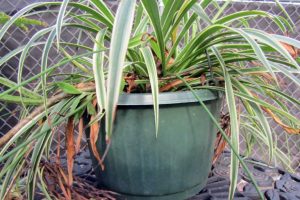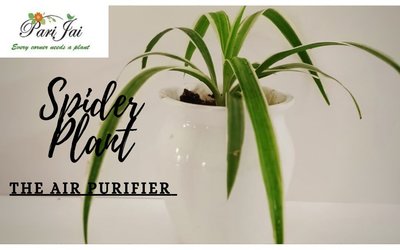Looks of Spider Plant
Spider plant, also known by the names, spider ivy and ribbon plant, is an easy to grow houseplant.
Its long and narrow leaves can reach a length measuring upto 20-45 cm and approx. 6-25 millimeters.
These are perennial plants with indefinite life span, which also end up out living their owners, provided these are nurtured properly. Thanks to their longevity, they end up becoming the legacy.
Spider Plant Uses
- The NASA Clean Air Study claimed that spider plant is an effective air purifier and helps eliminate air toxins like xylene (Sources- petroleum, coal tar, smoke) and formaldehyde (Sources- paints, coatings, glues, permanent press fabric, pesticides, fertilizers). Thus, reducing indoor pollution.
- The plant finds its use in various traditional medicines. Its tubular roots are consumed to treat bronchitis, bone fractures and burns. Its leaves are consumed in kenya.
- It can be used as an indoor plant not only because it purifies air but also it enhances the indoor beauty due to its decorative value.
- Spider plants can also be planted in gardens as well as in hanging pots at a partially shady place. It spreads beautifully on the ground and works as a cover to prevent soil erosion .
Care
- Soil
Plants love well drained soil so does the spider plant. The fully grown plants can tolerate drought for a while as well but not for very long.
- Temperature
The most suitable temperature for its good development is 18-32 degree Celsius. It cannot withstand frost.
- Water
Plants prefer the soil to dry between waterings to avoid root rot, so does the spider plant. Excess watering can produce brown leaf tips, which can also be due to buildup of chemicals present in water. You may use filtered water in that case. Water stress can also arise due to insufficient watering.
- Humidity
Belonging to the tropical rainforest, spider plants prefer humidity which keeps brown tips at bay. So, you can also place it in a bright bathroom of yours.
- Exposure
These require partly shaded sites and if grown indoors they love highly bright spots. Forbid direct sunlight to prevent scorching of leaves and enhance the striping on the leaves.
- Food
The fertilizing task can be done in summer and spring twice a month. Plant growth is slow in winter and autumn so fertilizer doesn’t find the need. Over-fertilization should be avoided to prevent brown leaf tips.
- Propagation
This task requires the plantlets of the plant. These are the miniature replica of the spider plant. So, these are easy to propagate.
- Repotting
Though the spider plants do not require repotting often but the task should be done in spring which is considered as an ideal time. If the roots start peeping out of the soil, then it’s time for some action.
Pests
These plants are hardy when it comes to pest attack. But yes, they are susceptible to some infestations, like spider mites, aphids, mealy bugs and whitefield may damage the plant. The plant can be saved using an insecticide mixed with vinegar if it worsens, otherwise, misting it with water will do the job. Spraying neem water on any plant can help save plants from bugs.

So, what are you waiting for? Hurry up and clean your indoor air with this NASA approved air purifier and give a pure breathing experience to your family.
Every Corner Needs A Plant

